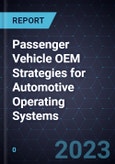OEMs to Rely on Tier Suppliers’ Embedded Hardware and Software Solutions Until Capable of Delivering In-house Standardized OS for Future Software-defined Vehicles
The automotive industry is undergoing a major transition and redefining the vehicle development process. To include numerous technologies tied to the concept of connected, autonomous, shared, and electric (CASE) mobility, OEMs have chosen to adopt the software-defined vehicle (SDV) development approach. With the SDV approach, OEMs extend features and function that they can update throughout the vehicle life cycle, which provides opportunities for recurring and sustainable revenue.
To achieve an SDV, OEM are redesigning vehicle electrical/electronic (EE) architecture by consolidating functions in domains and zones. They are making huge investments in software development, and specifically in a base software platform, that will enable them to extend software-driven features and functions called the vehicle operating system (OS).
KEY ISSUES ADDRESSED
- What is a vehicle OS, and how are OEMs defining it?
- What are the OEMs’ strategies in developing vehicle OSs?
- What are the key trends in the vehicle OS market?
- What challenges are OEMs facing in OS development?
- How will the Tier I suppliers’ role change in the value chain?
- What are the top growth opportunities in this market?
Table of Contents
1 Strategic Imperatives
- Why Is It Increasingly Difficult to Grow?
- The Strategic Imperative 8™
- The Impact of the Top 3 Strategic Imperatives on the Vehicle Operating System (OS) Industry
- Growth Opportunities Fuel the Growth Pipeline Engine™
2 Growth Opportunity Analysis
- Scope of Analysis
- Growth Drivers
- Growth Restraints
- Key Trends in the Vehicle OS Market
- What is an OS?
- Evolution of Vehicle OSs
- Future Vehicle OSs: Definition and Key Functions
- High-level Generic Vehicle OS Architecture
- Types of Vehicle OSs
- Vehicle OS Sourcing Strategies
- OEMs’ Challenges in SW Platform Development
- Change of Tier I Suppliers’ Role in the Value Chain
- Vehicle OS Ecosystem
3 OEM OS Development Strategies
- CARIAD VW.OS
- Hyundai Connected Car OS (ccOS)
- Toyota Arene OS
- MB.OS
- Nio
- Tesla
- Ford
- GM Ultifi
- BMW Neue Klasse
- Typical OEM.OS Strategies
- Key Insights from OEM.OS Strategies
- OEM OS Activity
- OEM.OS Strategy Benchmarking
- OEM Benchmarking
4 Open Source Software and Consortia
- AAOS
- OEMs Adopting AAOS
- AUTOSAR and AGL
- Cooperative Approach to OS and SW Development
5 OS Solution Developers
- Blackberry
- Elektrobit
- Red Hat
- Green Hills Software
- Wind River
- Vector Informatik
- OS Solution Benchmarking
6 Growth Opportunity Universe
- Growth Opportunity 1: SDVs Opening New Avenues for Repeatable Revenue Generation
- Growth Opportunity 2: Collaboration between OEMs and SW Companies for OS Development
- Growth Opportunity 3: Cloud Computing and Functional Virtualization will Open Opportunities for Cloud Technology Developers
- The Last Word
7 Next Steps
- Your Next Steps
- About the Analyst
- List of Exhibits
- Legal Disclaimer
Companies Mentioned (Partial List)
A selection of companies mentioned in this report includes, but is not limited to:
- Blackberry
- Elektrobit
- Red Hat
- Green Hills Software
- Wind River
- Vector Informatik
- OS Solution Benchmarking
- Hyundai Connected Car OS (ccOS)
- Toyota Arene OS
- MB.OS
- Nio
- Tesla
- Ford
- GM Ultifi
- BMW Neue Klasse
- CARIAD VW.OS








